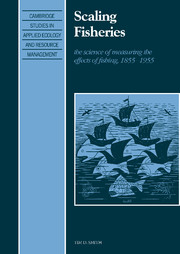Book contents
- Front Matter
- Contents
- Acknowledgements
- Preface to the Paperback Edition
- References
- Units used in the text
- Part I INTRODUCTION
- Part II DEVELOPING METHODS, 1855–1940
- 2 Research approaches, 1855–1890
- 3 Measuring the effect of fishing, 1890–1900
- 4 The International Council for the Exploration of the Sea, 1900–1920
- 5 Predicting fluctuations, 1920–1930
- 6 A priori methods, 1930–1940
- Part III THREE PARTIAL THEORIES, 1940–1955
- Notes
- References
- Index of people
- Subject index
5 - Predicting fluctuations, 1920–1930
Published online by Cambridge University Press: 22 September 2009
- Front Matter
- Contents
- Acknowledgements
- Preface to the Paperback Edition
- References
- Units used in the text
- Part I INTRODUCTION
- Part II DEVELOPING METHODS, 1855–1940
- 2 Research approaches, 1855–1890
- 3 Measuring the effect of fishing, 1890–1900
- 4 The International Council for the Exploration of the Sea, 1900–1920
- 5 Predicting fluctuations, 1920–1930
- 6 A priori methods, 1930–1940
- Part III THREE PARTIAL THEORIES, 1940–1955
- Notes
- References
- Index of people
- Subject index
Summary
[T]he fluctuation of year classes [is] a prominent, perhaps the predominating factor determining fluctuations in the fisheries.
Johan Hjort 1926Hjort's conclusions that the fluctuations in the catches were due, at least in part, to the large variability in the numbers of young herring and cod surviving from each year's spawning were accepted by almost all scientists by 1920. While D. W. Thompson continued to argue that herring scales could not reveal age precisely, and hence could not be relied on to reveal fluctuating age compositions as Hjort claimed, many other scientists began to demonstrate similar fluctuations in age frequency distributions for other species of fish.
Armed with Hjort's answer to the question posed to Sars now more than a half century earlier, and with the results of the ‘War Experiment’ demonstrating the effects of reducing fishing intensity, scientists entered the 1920s with a sense of optimism. One cause of the fluctuations of fish populations was known, and the possibility ‘of turning our knowledge to the practical guidance of the fishermen’ (Thompson, H. 1929) by predicting future catches began to attract the interest of several biologists working in the North Sea and in North America. Three approaches were taken. One was based on monitoring the varying age distributions by directly sampling the commercial catches or, using research vessels, sampling the population itself. This approach achieved moderate success for the North Sea haddock and East Anglia herring fisheries.
- Type
- Chapter
- Information
- Scaling FisheriesThe Science of Measuring the Effects of Fishing, 1855–1955, pp. 163 - 193Publisher: Cambridge University PressPrint publication year: 1994



